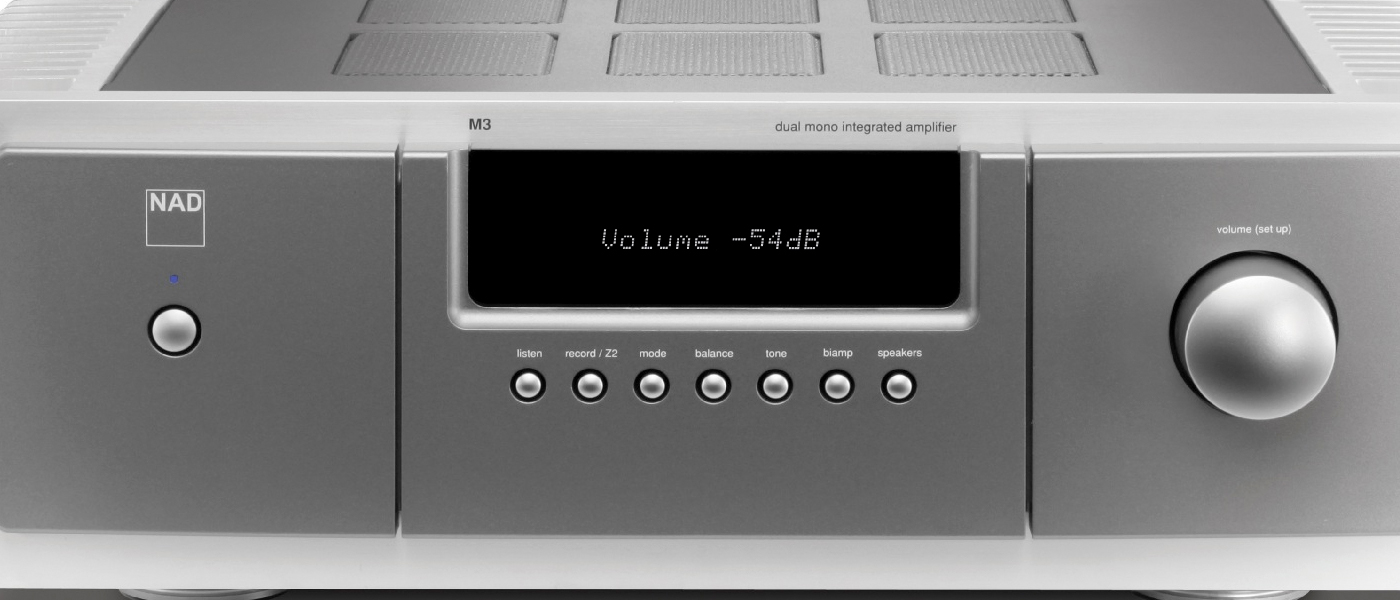Introduction to the MD-75 Integrated Amplifier
If you attend any of the myriad audio shows around the world these days, you will notice that in the high-end exhibits, they are likely to be using a turntable as the source, and tube preamplifiers/power amplifiers to drive the speakers. Ten years ago, one might have said that tubes and vinyl are raising their heads again. Now, they are here to stay and are routinely offered as an alternative to the digital world of music.
Ming Da is company based in China that exports tube preamplifiers, power amplifiers, and integrated amplifiers in various price ranges, including some very high end models. They sell direct, through Pacific Valve, rather than through dealers, so you really get a good bang for the buck. This review, my first of a Pacific Valve product, is on the MD-75, which is a stereo integrated amplifier. It has a detached power supply for low noise and interference, a remote for adjusting the motorized volume control, and you can switch between triode mode (40 watts/channel output) and ultra-linear mode (75 watts/channel output). You can “tube roll” if you wish, and the review unit came with optional Genelex 12AT7’s for the input stage, Black Treasure CV-181 driver tubes, and Black Treasure KT88 output tubes.
One very nice feature of this product is that, when you turn it on, the volume control rotates to the lowest volume setting, so you don’t accidentally start playing music at a volume that might startle you.
Specifications of the MD-75 Integrated Amplifier
- Design: Stereo Tube Integrated Amplifier
- Power Output: 40 Watts/channel in Triode Mode, 75 Watts/channel in Ultra-Linear Mode
- Tube Complement: Two EH 12AT7 Dual Triodes, Two EH 6SN7 Dual Triodes, Eight EH 6CA7 Output Tubes
- MFR: 10 Hz – 60 kHz, -2 dB
- THD+N: >1% at Full Output
- Input Sensitivity: 200 mv for Full Output
- Inputs: XLR and RCA
- Dimensions: 10″ H x 14.5″ W x 18″ D (Main Unit); 6″ x 5″ x 11.5″ (Power Supply)
- Weight: 75 Pounds Total
- MSRP: $2,367 USD (Base Price with EH 12AT7 Input Tubes, EH 6SN7 Driver Tubes and EH 6CA7 Output Tubes); $2,971 USD (with Genelex 12AT7 Input Stage Tubes, Black Treasure CV-181 Drivers, and Black Treasure KT88 Output Tube Options as Reviewed)
- Pacific Valve
- SECRETS Tags: Amplifiers, Integrated Amplifiers, Tubes
The Design of the MD-75 Integrated Amplifier
The MD-75 has a four gain-stage circuit. The 12AT7’s are dual triodes, operating in Pure Class A (most preamplifiers operate this way), with two gain stages. They produce a single-ended voltage gain signal, which then passes through the driver tubes that are phase inverters with some gain, then on to the output stage where the output tubes produce current gain. Since there is an even number of gain stages, the output is in phase (not inverted). The MD-75 would be classified as operating in Push-Pull, Class AB.
The standard version of the MD-75 comes with two 6SN7 drivers and with eight 6CA7 output tubes. However, there are several options: you can purchase the MD-75 with Tung Sol 6SN7’s or Black Treasure CV-181’s instead of the standard EH 6SN7’s for the drivers , and you can also get Tung Sol 12AT7’s (input stage), Tung Sol 6550’s, Tung Sol KT88’s, Genelex KT88’s, or Black Treasure KT88’s (output stage). Each has its own sonic characteristics and is one of the things that “tube rollers” do. The sockets are the same, and the only thing that needs to be changed is the bias voltage on the grid of the output tubes.
When I unpacked the contents of the shipping box, this is what was inside:
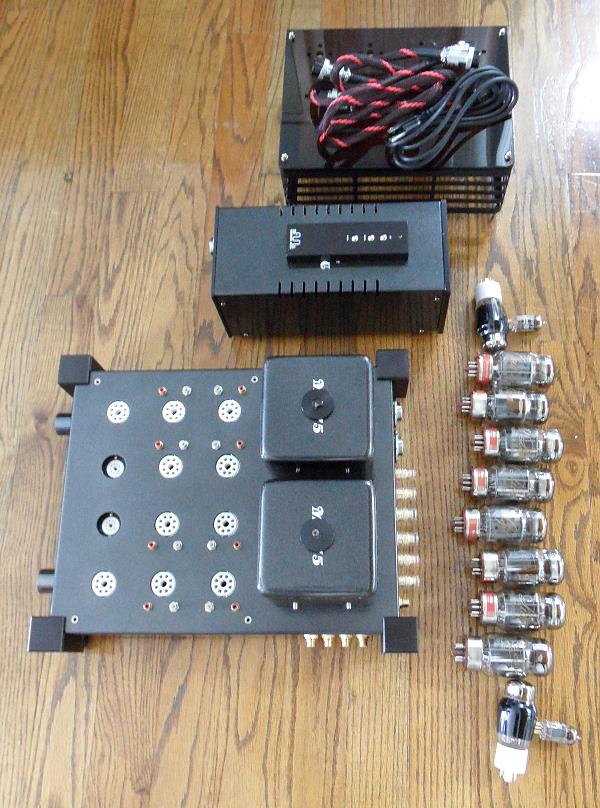
The tubes were all in individual boxes, with the KT88’s marked as to which socket they should be inserted into (the factory sets the bias for each KT88 and its corresponding socket). There is a plastic cover with ventilation holes to use if you have small children, but otherwise, I think you will prefer it, as I do, with the cover off.
The power supply (solid state) is housed separately, and is connected to the rear panel of the MD-75 with two thick cables:
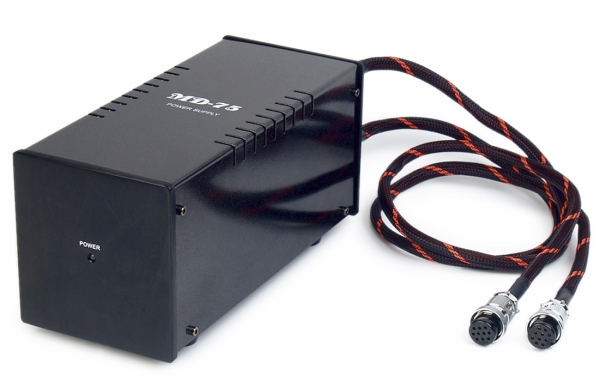
Below, is a photo of the rear panel, with the 4 ohm and 8 ohm speaker binding posts, and the power supply jacks. There is also a pair of pre-in RCA jacks should you just want to bypass the preamplifier and just use the power amplifier.
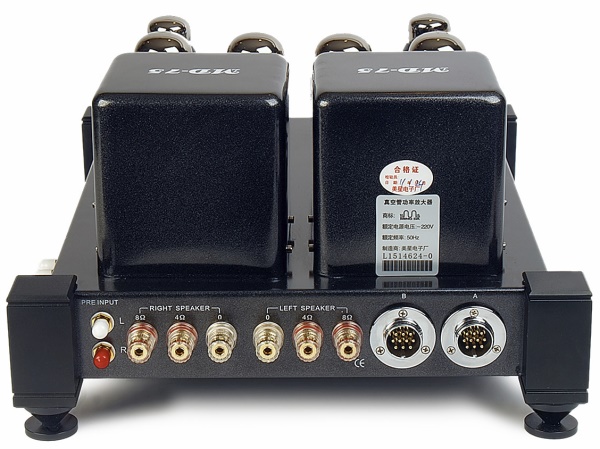
There are four pairs of RCA input jacks on the side, for Aux, CD, Tape, and Tuner. So, even the labels for the inputs are “Retro” (do you still have a cassette tape deck?) More likely, you would use them for your CD player, media player, and perhaps the output from a phono preamplifier.
The inside of the chassis has one very small circuit board, but the majority of the circuit is hand wired point-to-point. Notice how meticulous the wires are laid out. They all run parallel or perpendicular . . . and exactly so.
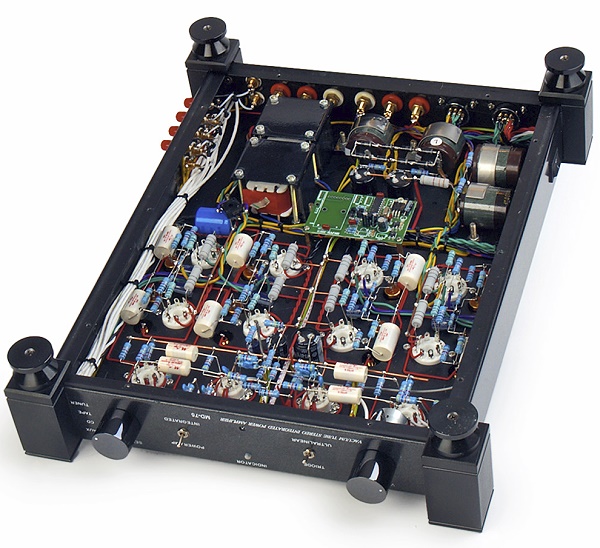
Once the tubes are inserted, and the power supply is connected to the main unit, you plug the power supply into the wall. This is important, as you should not plug the power supply into the wall and then plug the power cables into the main unit.
OK, so it’s all together, plugged in, you take a deep breath, and flip the power on/off toggle to the on position. If you have done everything correctly, the amplifier will look like this (you can see the four sets of RCA input jacks on the right rear):
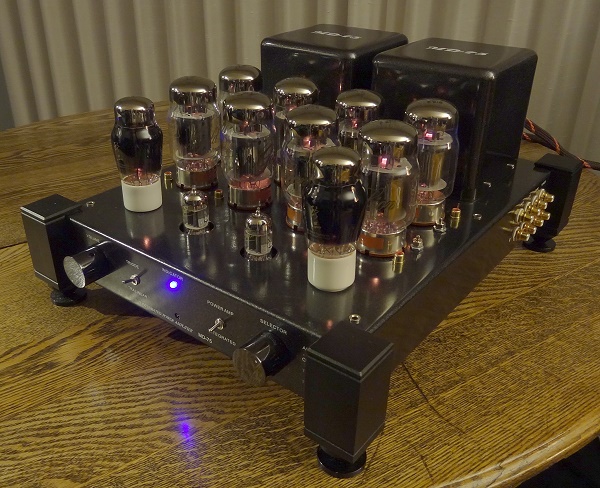
The tube filaments will all glow orange-red. A blue LED will glow on the front to tell you all is well. On the left is the volume control, which is motorized, and which rotates fully counter clockwise when you turn the amplifier on. To the right of the volume control is a toggle to select Triode Mode or Ultra-Linear Mode, then the LED, a toggle to select Power Amp or Integrated, and finally, the Input Selector knob.
The MD-75 comes with the bias voltage for the output tubes adjusted. Nevertheless, I checked and adjusted the bias using a meter and a probe that is inserted into the middle of the RCA jack that is situated near each output tube (the positive probe goes into the RCA jack, and the negative probe is attached to the chassis as the ground connection). Using a small screwdriver, I turned the slotted dial next to the RCA jack until I was within the recommended range. You will need a long, thin screwdriver with a small tip for this. I bought one at Home Depot. You probably already have a volt-meter, but if not, an inexpensive one will do just fine.
A close-up photo of the RCA jacks and bias adjustment screws is shown below. In the second photo, I am using the small screwdriver to adjust the bias voltage.
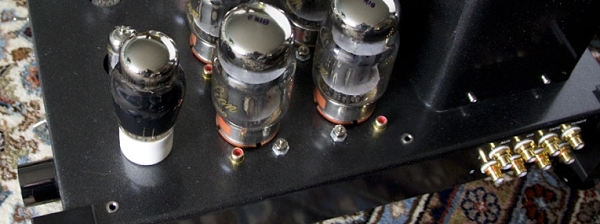
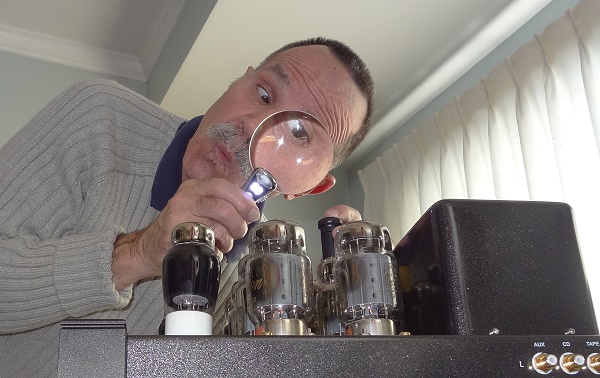
The MD-75 Integrated Amplifier In Use
I listened to the MD-75 using an OPPO BDP-95 universal player and Magnepan MG 1.7 planar speakers. Cables were Wireworld Platinum Eclipse 6 interconnects and Wireworld Eclipse 6 speaker cables.
Recorders (a musical instrument that sounds like a pan flute) are wonderfully musical, with an uplifting sound that could probably never be used to play the “blues”. Tubes add to that musicality, and I thoroughly enjoyed the sound through the MD-75. I ended up preferring ultra-linear mode with its increased power and dynamic range. The presence of the comparatively large (compared to solid state) amounts of second and third ordered harmonics simply add to the pleasure.

Strings are great instruments with tube amplifiers because the harmonics add richness that can be lost when the recording microphones are not close to all of the stringed instruments being played, which is generally the case. It does not replace lost sound, but puts back in some of the pleasure that would be experienced if you were in the audience at the symphony hall. That is exactly what I felt when I listened to this SACD of a stringed quartet.

I also listened to numerous other albums, and with just 75 watts, it is not for rattling the windows with Stravinsky. This is an amplifier to sit back and enjoy easy listening types of music. And, it does a great job of it. Warn and soothing would be a totally encompassing description of the sound quality.
The MD-75 Integrated Amplifier On the Bench
All distortion measurements were within an 80 kHz bandwidth. Both channels were driven, with an 8 ohm load. I did not run tests at the 4 ohm tap since this simply limits the voltage, and I did not run tests on the power amplifier by itself (there is a set of RCA pre-in jacks to use just the power amplifier section).
Each distortion graph will begin with the MD-75 in triode Mode, followed by the same measurement with the amplifier in ultra-linear mode.
At 5 volts and a 1 kHz sine wave, distortion was less than 0.1% in triode mode.
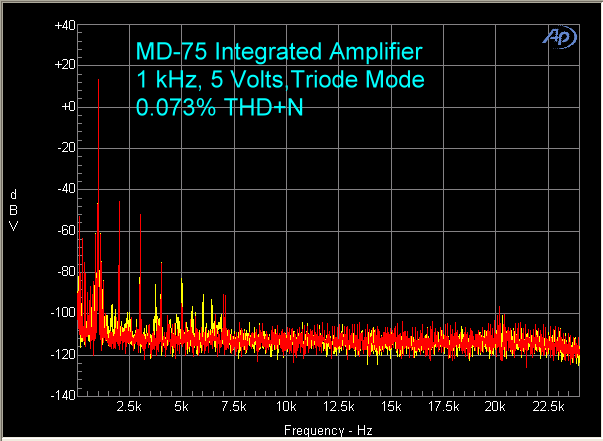
In ultra-linear mode, distortion dropped to less than 0.05%. In both cases, the second order harmonic was predominant. Also, in ultra-linear mode, the difference between the height of the second order harmonic and third was greater.

In triode mode, 1 kHz and 15 volts output, distortion was less than 0.5%, which is a reasonable number for a tube amplifier.
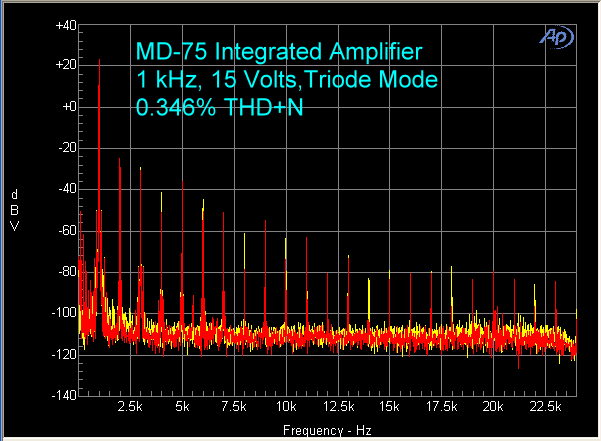
In ultra-linear mode, the 15 volt distortion measurement was not significantly different than it was in triode mode.
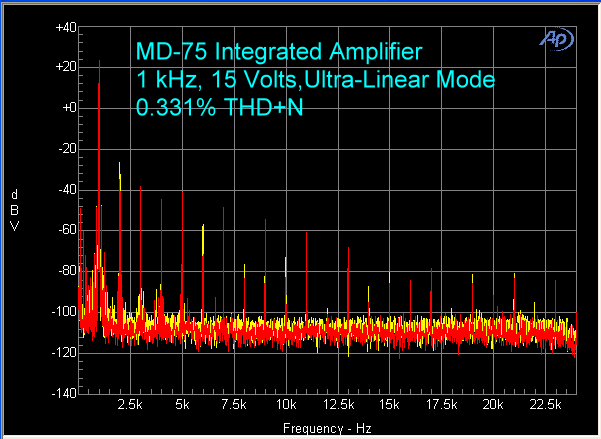
In triode mode, maximum output before clipping was 40 watts, but in ultra-linear mode, it was 75 watts. So, I am only showing the 20 volt (50 watts into 8 ohms) measurement in ultra-linear mode. The result was less than 0.5% THD+N, a good number.
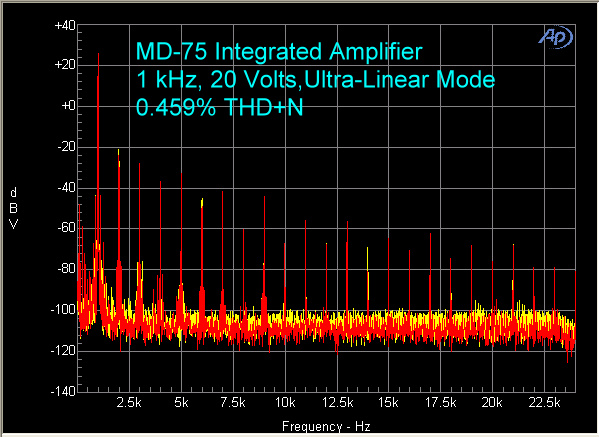
Looking at the spectrum when using 19 kHz and 20 kHz sine waves as the test signal is always interesting. Here is the graph with 5 volts output in triode mode. The B-A (20 kHz minus 19 kHz) peak at 1 kHz was 38 dB below the fundamentals. Notice also the IM peaks surrounding the fundamental peaks.

In ultra-linear mode, the B-A peak was 55 dB below the fundamental (the lower the peak, the better). So here, we see an advantage in the ultra-linear mode. Also, there are 8 IM peaks on either side of the fundamental peaks in triode mode, but 7 peaks in ultra-linear mode. These are very small details, but can add up to discernible differences in the sound.
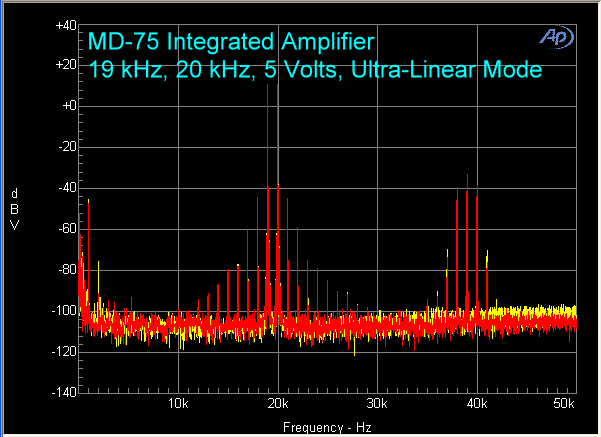
At 20 volts (50 watts), ultra-linear mode, the spectrum is filled with IM peaks. This is a point when the midrange would begin to start sounding congested. However, most of the time, when listening to music, we are only using a few watts.

Using 60 Hz and 7 kHz as test signals, there was less than 0.4% IMD in triode mode at 5 volts output.
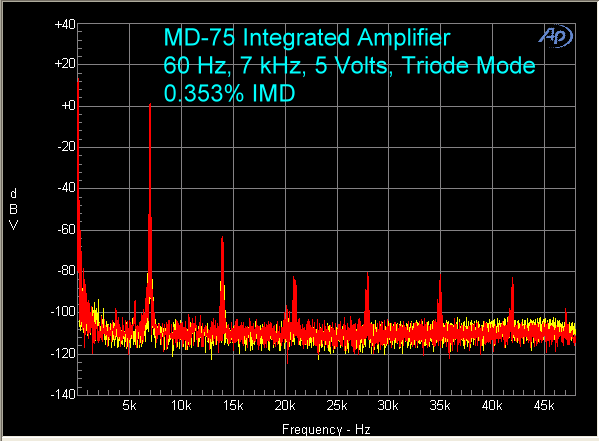
In ultra-linear mode, IMD dropped to less than 0.2%, which is excellent.
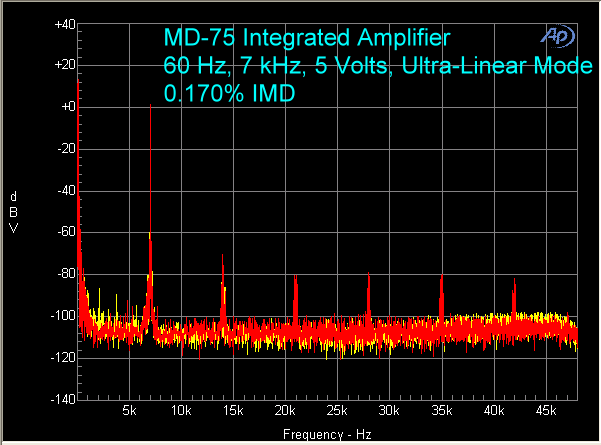
At 15 volts output, IMD was 3.4% in triode mode, which would result in some congestion in the midrange sound.
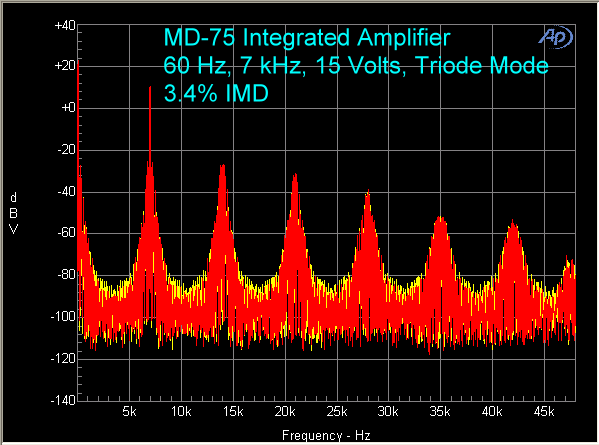
However, in ultra-linear mode, MID was 1.28%, which is much more reasonable. (I know what you solid state guys are thinking, but you have to put on a different hat when dealing with tube amps).
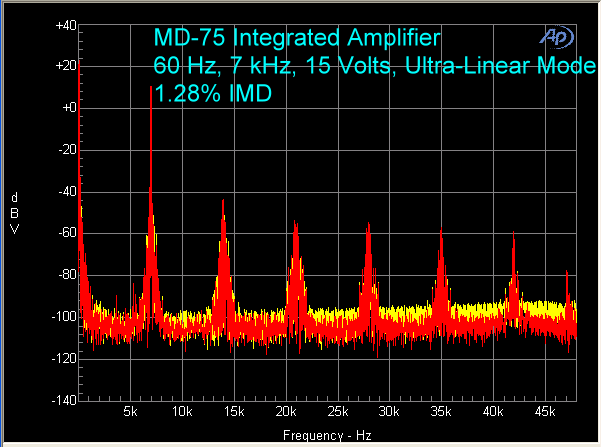
Even at 20 volts, the IMD in ultra-linear mode was less than it was in triode mode at 15 volts.
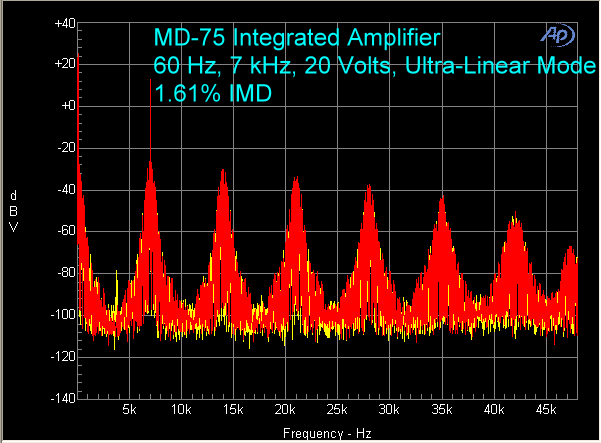
The frequency response in triode mode was down almost 2 dB at 20 kHz. This produces a very smooth sound that tube-o-philes love.
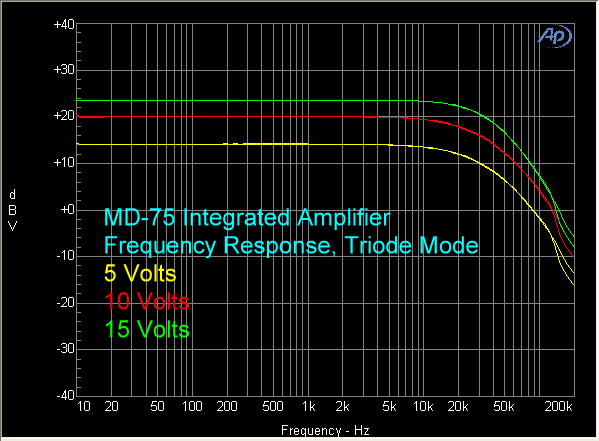
In ultra-linear mode, the response was the same, down 2 dB at 20 kHz.
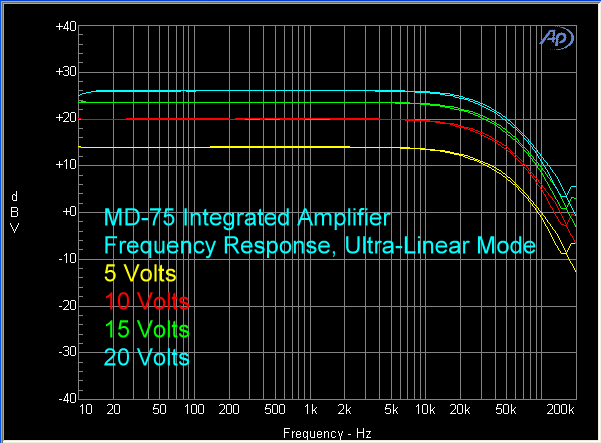
THD+N vs. Frequency for triode mode is shown below. It’s reasonably flat from 20 Hz up to 10 kHz, then rises up to 30 kHz before declining.
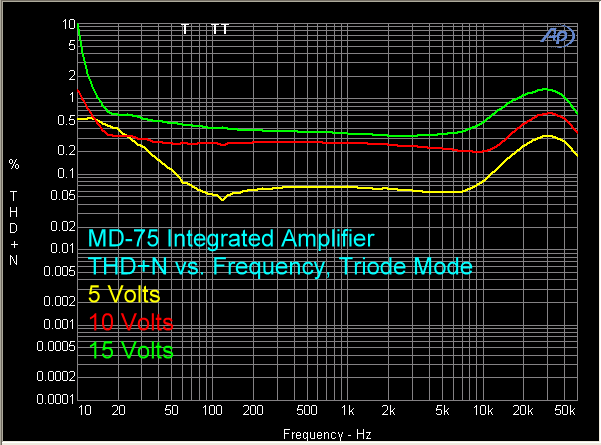
In general, ultra-linear mode showed less distortion in the audible band for the various output voltages tested.
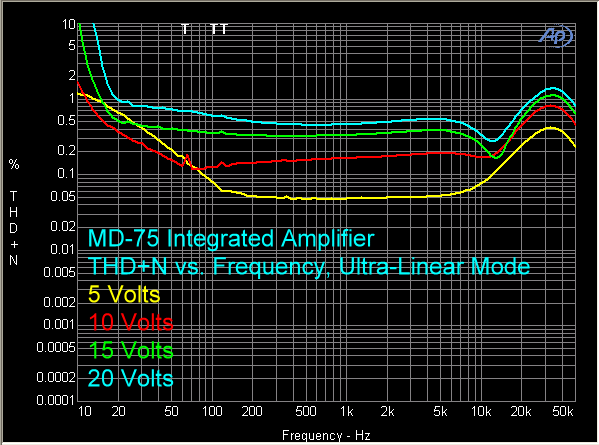
Power output in triode mode indicated a sharp knee at 35 watts, and clipping (1% THD+N) at 40 watts.
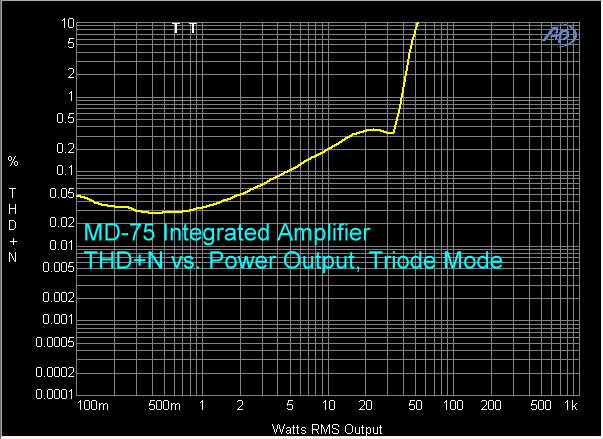
The sharp knee in ultra-linear mode was at 70 watts, and clipping at 75 watts, exactly on spec.
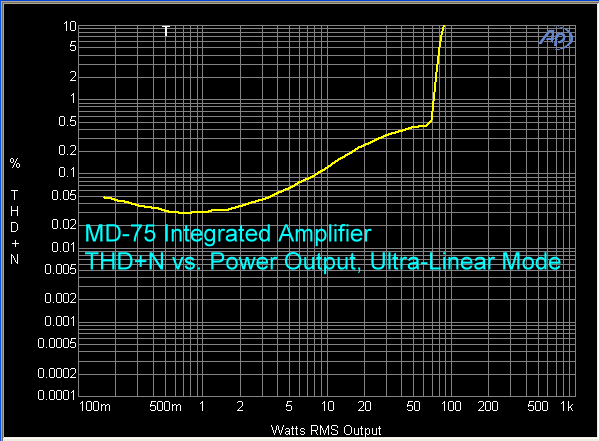
Conclusions About the MD-75 Integrated Amplifier
If you are a solid state user who is in the mood to go “Retro”, you are a bit late, as tubes re-emerged a while ago, and they are everywhere. But, seeing as how you are in the mood, regardless of the timing, the Ming Da MD-75 represents a very good value, and an excellent way to get into the world of tube sound. You don’t have to worry about matching a preamplifier to the power amplifier, because the MD-75 is integrated. It is solidly built, has motorized remote control of the volume, sounds like tubes should sound, and you will have a terrific conversation piece to show your friends.


